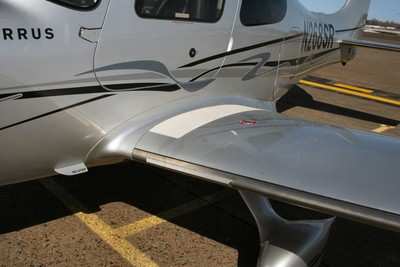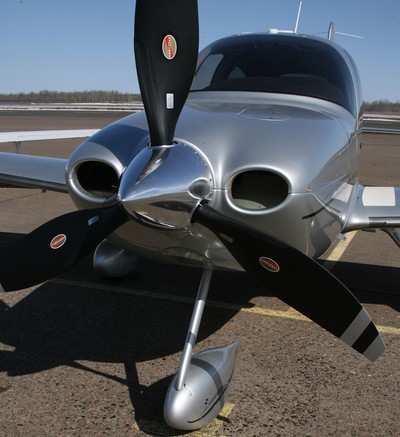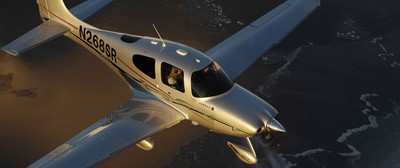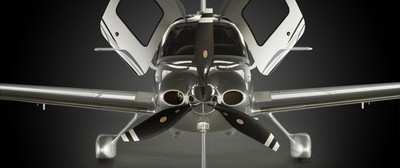Another Step In A Very Evolutionary Program
Flight Test Report and Analysis by ANN Editor-In-Chief Jim
Campbell
When ANN last regaled you with tales from our G3 flight test,
ANN Editor-In-Chief Jim Campbell, was doing one of the things he
does best... taking it slow.

The SR22-G3 continues to do well in the slow-flight regime,
despite the continual nay-sayers who obviously don't know the
airplane. Flap extension produces a negligible trim change with the
first "notch" (about 50% of their deployable capability) and a more
notable amount with the second/last position. Max flap extension
speeds are generous… 119 knots for half deployment, and 104
knots for the works. Basic, non-augmented deceleration takes place
sparingly and the SR22-G3 holds its considerable energy well. A
little bit of yanking and banking, more formally known as
"G-Induced deceleration" offers a more rapid result and allows one
to bleed speed off a bit quicker with 1.5-2 G pulls… but
otherwise the behavior is quite solid and overtly symmetrical.

Once again, to slow a Cirrus down (an unnatural state of affairs
for the sweet little bird), pull the power back all the way, and
wait... a while. Don't use a stopwatch, take a calendar... you may
be waiting a while (grin). With flaps up, in particular, the G3's
deceleration profile will take its own sweet bloody time. To slow
it down, it's going to require significant pitch persuasion to get
anywhere near the stall regime (a little more than we're used to
with the elder birds), though the slow-flight behavior boasts
excellent controllability and little discernible loss of
effectiveness as you work your way down to 65 kts. A modest root
buffet, of light frequency and amplitude, shows up in the 60s as
the bird gets to a point of "stalling"… which is mostly a
slight pitch buck of limited amplitude and frequency before finally
giving up the ghost with barely a shudder… which is going to
take a LOT of aft stick to maintain to a complete and definable
departure--such as it is. Lateral control effectiveness continues
to be very good, while rudder authority is simply outstanding. The
clean stall comes at near to 65-70 knots… but we didn't get
much of a departure, no matter how hard we tried.

Drop the flaps and the bird takes on an even more modest
persona. Roll control remains quite aggressive, overall control
pressures ease off a bit as you slow down, and the rudder rocks on
as though you were still doing cruise speed… There is an
excellent and somewhat more prominent airframe (mostly root) buffet
that comes into play as you drop below 75 kts and gains prominence
as you work your way into the 60 knot range. It remains fairly
moderated through the break and sports a slightly more aggressive
amplitude (from the G2) that is hard to mistake but is (also)
hardly worrisome. The buffet becomes more prominent under load, as
demonstrated during accelerated stalls… excellent. One thing
about the fully stalled SR22… once you get everything
hanging out and stall the bird, the sink rate increases
dramatically… so be aware of that as you start working into
landing approaches--especially on short final. Recovery is a simple
matter of decreasing pitch pressure and letting the bird reassert a
proper attitude of attack. Power arrests the attendant sink rate
immediately.

In a fully stalled, and I do mean FULLY stalled, configuration,
I booted the hell out of the rudder, to the point of aggressively
rocking/rolling the bird side to side as the aircraft pitched and
buffeted through its critical angle of attack. Stalls are even more
symmetrical than before and the rudder coupling is just plain
awesome... even if you exacerbate the game to the point where it
starts to slide off on a wing (and with NO apparent willingness to
break hard to either side), you can arrest the condition with
simple rudder, immediately and aggressively, even well into a
roll-over (past 30-45 degrees). Excellent.

OK... since we're in the neighborhood (aerodynamically speaking)
once again, let's address the spin issue. A lot has been made of
the fact that the Cirrus manual says that the proper recovery for
accidental spins is using the chute. The manual states that, "The
SR22 is not approved for spins, and has not been tested or
certified for spin recovery characteristics. The only approved and
demonstrated method of spin recovery is activation of the Cirrus
Airframe Parachute System. Because of this, if the aircraft
'departs controlled flight,' the CAPS must be deployed."

I've previously reported that despite some pretty aggressive
coordination abuses, I found the fully stalled SR22 series to be
remarkably well-behaved and observed little tendency toward overt
or unexpected autorotation. Let me repeat previous flight test
results with the following caveat... it was good before, and it's
even better now. The beast will buffet up a storm, and break
lightly into the bank if you insist on exacerbating the exercise,
but there is no overt yawing associated with that, and rudder
control remains sterling throughout. If someone gets into an
inadvertent spin, they're going to have to really screw up. A pilot
not seeing a spin coming just doesn't need remedial flight
instruction, they need a seeing eye dog (preferably an Airedale...
grin).

As previously noted, I wish I could speak more about the true
spin modes of the SR series… I have some insight from prior
test pilots and a few "interesting" flights that suggests the most
significant issues involved concern about the rotation rate
involved in a stable-state spin and the time it's going to take to
arrest the resultant rotational inertia and actually
recover… Cirrus has consented to let me go out and abuse
this process a bit more in the not too distant future, but we're
saving that flight for a future episode of Aero-TV... if you don't
believe the words, I'm damned sure you'll believe the video. At
some point, I look forward to the chance to explore that
part of the envelope… I have great confidence (and I'm not
exactly saying why -- hint, hint...) that the airplane will recover
well, if you have the insight and altitude to arrest the
autorotation in a proper conventional manner.

The SR22 has always been easy to land and boasts consistent
behavior through most configurations. Most notable, though, is the
extra mass inertia carried through in the landing by the somewhat
heavier Turbo bird. This means that one needs to watch speed and
energy, when using short strips, because the bird does want to keep
moving. It takes proper energy management to eke out the best
short-field response.
ONE Last Part... To Be Continued
 Classic Aero-TV: The Switchblade Flying Car FLIES!
Classic Aero-TV: The Switchblade Flying Car FLIES! ANN FAQ: Q&A 101
ANN FAQ: Q&A 101 ANN's Daily Aero-Term (04.12.24): Discrete Code
ANN's Daily Aero-Term (04.12.24): Discrete Code ANN's Daily Aero-Term (04.13.24): Beyond Visual Line Of Sight (BVLOS)
ANN's Daily Aero-Term (04.13.24): Beyond Visual Line Of Sight (BVLOS) ANN's Daily Aero-Linx (04.13.24)
ANN's Daily Aero-Linx (04.13.24)










